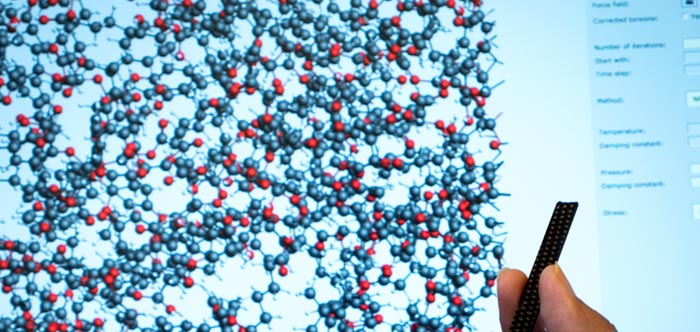Healable carbon fiber composite offers path to long-lasting, sustainable materials

Researchers have created a new type of carbon fiber reinforced material that is as strong and light as traditionally used materials, but can be repeatedly healed with heat, reversing any fatigue damage. This also provides a way to break it down and recycle it when it reaches the end of its life. Aniruddh Vashisth, University of Washington assistant professor of mechanical engineering developed atomic-scale simulation software (seen on the monitor in the background) to help understand the underlying mechanics of the new material.
Credit: Andy Freeberg/University of Washington
Because of their high strength and light weight, carbon-fiber-based composite materials are gradually replacing metals for advancing all kinds of products and applications, from airplanes to wind turbines to golf clubs. But there’s a trade-off. Once damaged or compromised, the most commonly-used carbon fiber materials are nearly impossible to repair or recycle.
In a paper published Nov. 2 in the journal Carbon, a team of researchers describes a new type of carbon fiber reinforced material that is as strong and light as traditionally used materials but can be repeatedly healed with heat, reversing any fatigue damage. This also provides a way to break it down and recycle it when it reaches the end of its life.
“Developing fatigue-resistant composites is a major need in the manufacturing community,” said co-lead author Aniruddh Vashisth, University of Washington assistant professor of mechanical engineering. “In this paper, we demonstrate a material where either traditional heat sources or radio frequency heating can be used to reverse and postpone its aging process indefinitely.”
The material is part of a recently developed group known as carbon fiber reinforced vitrimers, named after the Latin word for glass, that show a mix of solid and fluid properties. The materials typically used today, whether in sporting goods or aerospace, are carbon fiber reinforced polymers.
Traditional carbon fiber reinforced polymers typically fall into two categories: thermoset or thermoplastic. The “set” variety contains an epoxy, a glue-like material where the chemical links holding it together harden permanently. The “plastic” version contains a softer type of glue so it can be melted back down and reworked, but this becomes a drawback for high strength and stiffness. Vitrimers on the other hand, can link, unlink and relink, providing a middle ground between the two.
“Imagine each of these materials is a room full of people,” Vashisth said. “In the thermoset room, all of the people are holding hands and won’t let go. In the thermoplastic room, people are shaking hands and moving all around. In the vitrimer room people shake hands with their neighbor but they have the capacity to exchange handshakes and make new neighbors so that the total number of interconnections remains the same. That reconnection is how the material gets repaired and this paper was the first to use atomic-scale simulations to understand the underlying mechanisms for those chemical handshakes.”
The research team believes vitrimers could be a viable alternative for many products currently manufactured from thermosets, something badly needed because thermoset composites have begun piling up in landfills. The team says that healable vitrimers would be a major shift toward a dynamic material with a different set of considerations in terms of life-cycle cost, reliability, safety and maintenance.
“These materials can translate the linear life cycle of plastics to a circular one, which would be a great step toward sustainability,” said co-senior author Nikhil Koratkar, professor of mechanical, aerospace and nuclear engineering at Rensselaer Polytechnic Institute.
The research team also includes Mithil Kamble and Catalin Picu at Rensselaer Polytechnic Institute and Hongkun Yang and Dong Wang at the Beijing University of Chemical Technology. This research was funded by the U.S. Army and NASA through the Vertical Lift Research Centers of Excellence program, the National Science Foundation, the John A. Clark and Edward T. Crossan Chair Professorship at Rensselaer Polytechnic Institute, the University of Washington, and the company Software for Chemistry & Materials.
For more information, contact Vashisth at vashisth@uw.edu and Koratkar at koratn@rpi.edu.
Grant number: 2015750
Journal: Carbon
DOI: 10.1016/j.carbon.2021.10.078
Article Title: Reversing fatigue in carbon-fiber reinforced vitrimer composites
Article Publication Date: 2-Nov-2021
All latest news from the category: Materials Sciences
Materials management deals with the research, development, manufacturing and processing of raw and industrial materials. Key aspects here are biological and medical issues, which play an increasingly important role in this field.
innovations-report offers in-depth articles related to the development and application of materials and the structure and properties of new materials.
Newest articles

Innovative 3D printed scaffolds offer new hope for bone healing
Researchers at the Institute for Bioengineering of Catalonia have developed novel 3D printed PLA-CaP scaffolds that promote blood vessel formation, ensuring better healing and regeneration of bone tissue. Bone is…

The surprising role of gut infection in Alzheimer’s disease
ASU- and Banner Alzheimer’s Institute-led study implicates link between a common virus and the disease, which travels from the gut to the brain and may be a target for antiviral…

Molecular gardening: New enzymes discovered for protein modification pruning
How deubiquitinases USP53 and USP54 cleave long polyubiquitin chains and how the former is linked to liver disease in children. Deubiquitinases (DUBs) are enzymes used by cells to trim protein…



